OBSERVATORY OF MATERIAL CHANGE
CENTER FOR THE POLYCHLORINATED BIPHENYLS
Fall 2020
Harvard University Graduate School of Design
Advised by Rosalea Monacella
Harvard University Graduate School of Design
Advised by Rosalea Monacella
The project
proposes the establishment of the federal agency US National Observatory of
Material Change, and its New Bedford-based chapter Center for the
Polychlorinated Biphenyls.
Both organizations are focused on Material Change, which occurs in parallel to Climate Change and is defined as the radical transformation of the planet’s surficial materiality as a result of anthropogenic actions. Their work supports the monitoring of the terrestrial and aquatic contamination from both scientific and cultural perspectives.
At a national scale, the agency’s scientific efforts are developing methods for the biological metabolism of the toxic chemicals, in order to reduce biodiversity loss and negative health effects. Meanwhile, the agency’s cultural work is re-evaluating the materially-altered—contaminated—landscapes, changing their designation from “waste site” to “Material Change Heritage Site”. While these sites are chosen to be remediated—when possible—, they are also recognized for their significant contribution of archaeological and geologic evidence for the history of Material Change.
Both organizations are focused on Material Change, which occurs in parallel to Climate Change and is defined as the radical transformation of the planet’s surficial materiality as a result of anthropogenic actions. Their work supports the monitoring of the terrestrial and aquatic contamination from both scientific and cultural perspectives.
At a national scale, the agency’s scientific efforts are developing methods for the biological metabolism of the toxic chemicals, in order to reduce biodiversity loss and negative health effects. Meanwhile, the agency’s cultural work is re-evaluating the materially-altered—contaminated—landscapes, changing their designation from “waste site” to “Material Change Heritage Site”. While these sites are chosen to be remediated—when possible—, they are also recognized for their significant contribution of archaeological and geologic evidence for the history of Material Change.
In New Bedford, the Center for the Polychlorinated Biphenyls is supporting the documentation and remediation of the PCB-altered landscapes along the Upper Harbor. The proposed landscape is exhibiting moments of transformation and metabolism of PCBs, but also of archaeological and geologic surveys that collect evidence of the collapsed local/national and human/geologic histories of the 20th century.

Map of Material Change in the U.S. Territory. White dots illustrate the current Superfund Sites and black crosses the current EPA-approved PCBs-waste management facilities. White areas are determined by the current Superfund sites and are superimposed on the current geologic layers to illustrate the new layer of Material Change and the Anthropocene.
 Traces of Material Change through time and space, involving the PCB production in Anniston, Alabama and Sauget, Illinois, their use in New Bedford, MA and then their disposal in Belleville, Michigan.
Traces of Material Change through time and space, involving the PCB production in Anniston, Alabama and Sauget, Illinois, their use in New Bedford, MA and then their disposal in Belleville, Michigan.
Spheres of Stakeholders involved in the PCB contamination, but also its proposed biological and vegetative remediation, from an individual to a planetary level.

 Taxonomy that documents the particular PCBs that have contaminated New Bedford (labeled as Aroclors), current strategies for collection and screening of PCBs as well as various recent examples and experiments of phytoremediation and microbial metabolism of PCBs.
Taxonomy that documents the particular PCBs that have contaminated New Bedford (labeled as Aroclors), current strategies for collection and screening of PCBs as well as various recent examples and experiments of phytoremediation and microbial metabolism of PCBs.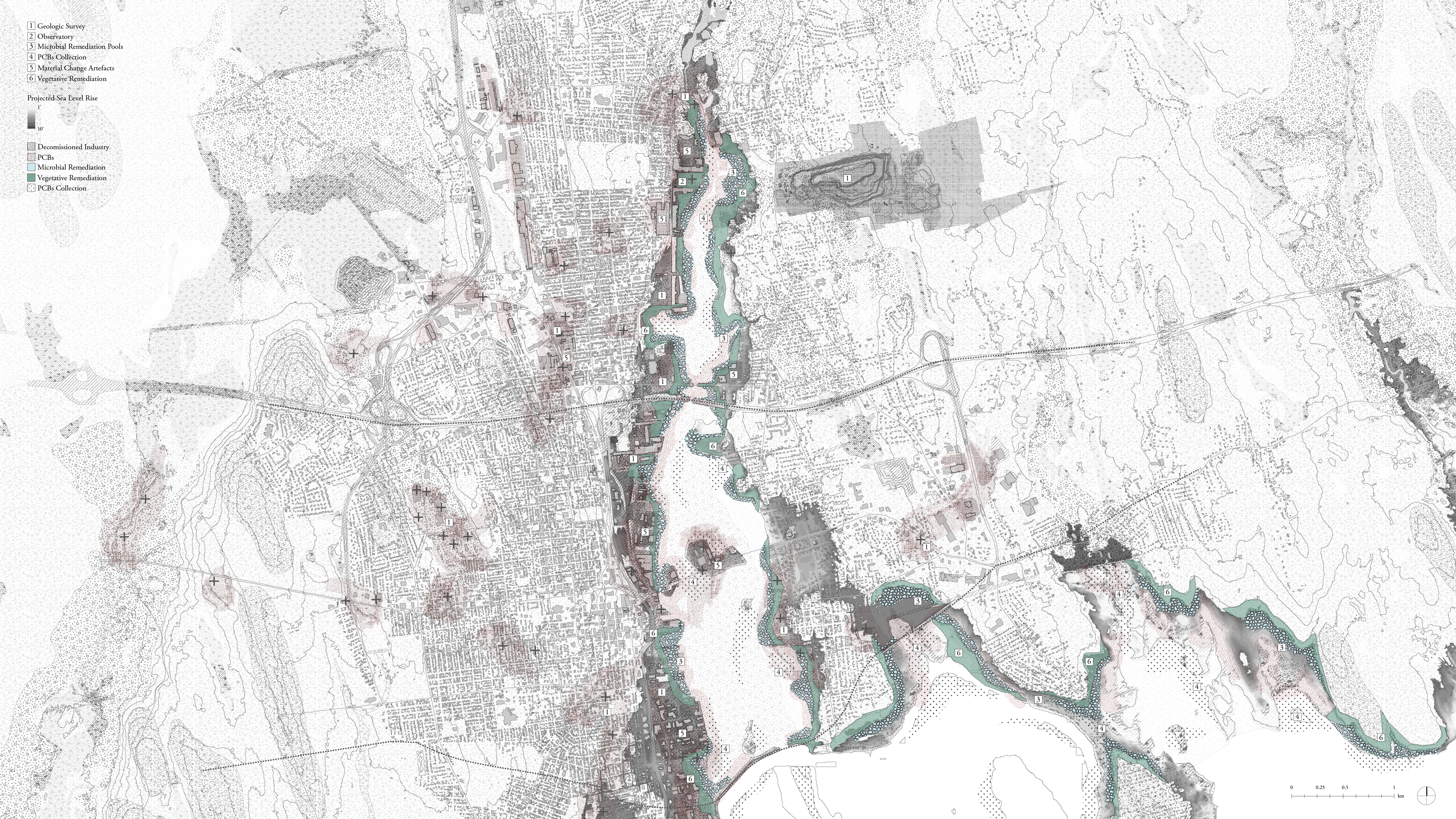
Map illustrates the contamination of the Harbor of New Bedford with PCBs, with the Upper Harbor being the most contaminated by the industry Aerovox Corp. The map also illustrates with crosses the various waste-management facilities as well as the various aquifers and water bodies, arguing that contamination is ultimately uncontrollable and subject to the various water flows across the site.
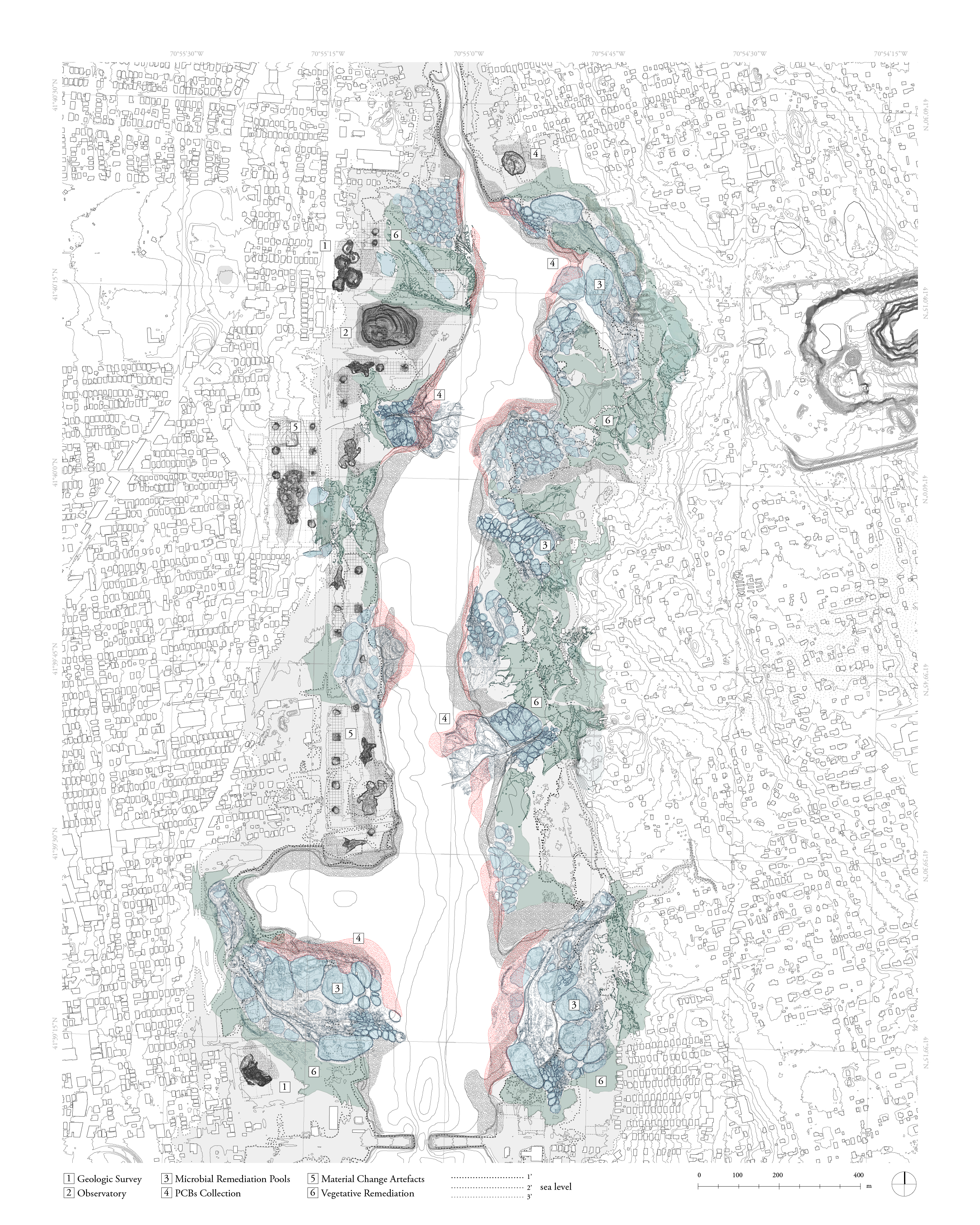 Site plan of the proposed Center for the Polychlorinated Biphenyls, located in the Upper Harbor of New Bedford, MA. The design proposal includes the creation of pools for the microbial remediation of PCBs, the addition of vegetative layers for additional remediation, areas of excavation, and archaeological and geological surveys on site.
Site plan of the proposed Center for the Polychlorinated Biphenyls, located in the Upper Harbor of New Bedford, MA. The design proposal includes the creation of pools for the microbial remediation of PCBs, the addition of vegetative layers for additional remediation, areas of excavation, and archaeological and geological surveys on site.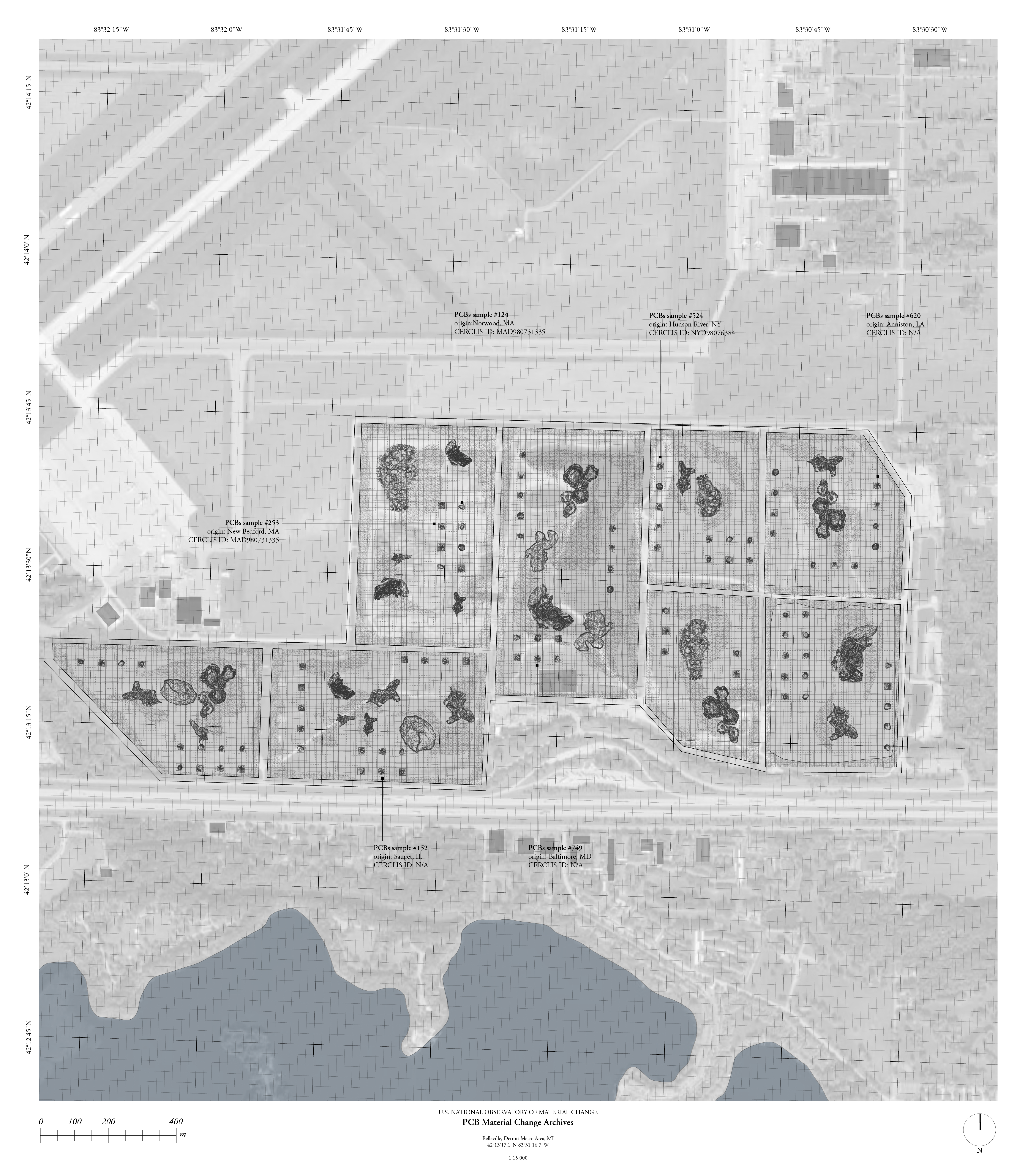 While in New Bedford there are opportunities for the remediation of PCBs and the investment in a less contaminated future, the Waste Management Facility in Belleville, MI is doomed to remain highly contaminated. It is proposed, though, that the site is decomissioned as a waste management facility and it becomes an archival area that has collected and indexed the Material Change that is happening throughout the US territory.
While in New Bedford there are opportunities for the remediation of PCBs and the investment in a less contaminated future, the Waste Management Facility in Belleville, MI is doomed to remain highly contaminated. It is proposed, though, that the site is decomissioned as a waste management facility and it becomes an archival area that has collected and indexed the Material Change that is happening throughout the US territory.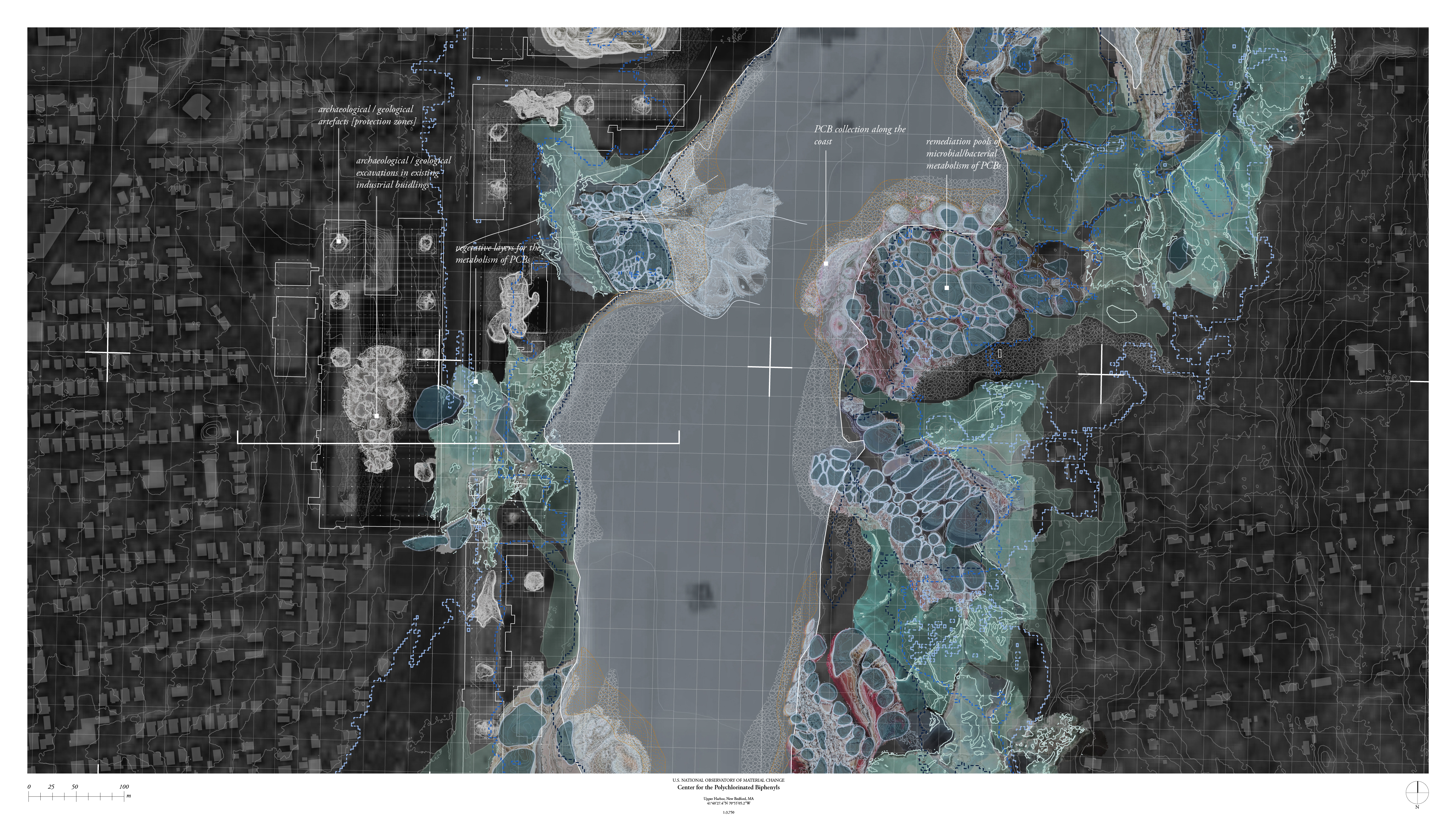
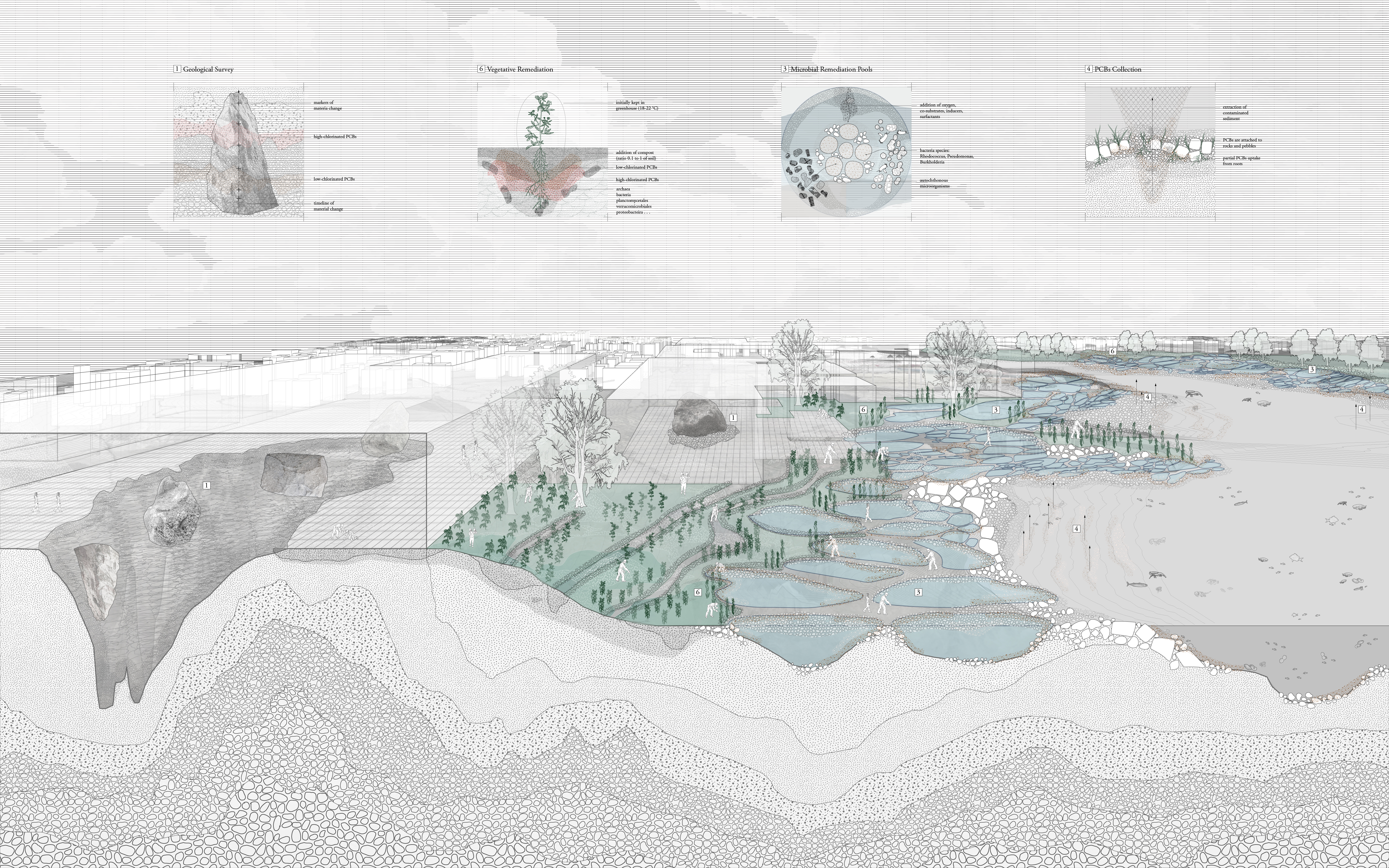 Back in New Bedford, MA, the microbial pools and vegetative layers metabolize and remediate the PCB contamination on site.
Back in New Bedford, MA, the microbial pools and vegetative layers metabolize and remediate the PCB contamination on site.
 While the remediation on site is metabolizing and erasing PCBs, certain excavation sites in current industrial buildings uncover more contaminants that reveal knowledge for archaeological and geological surveys. In the larger transformation of PCBs on site, these surveys become places of preservation of artefacts that reveal the 20th century environmental history.
While the remediation on site is metabolizing and erasing PCBs, certain excavation sites in current industrial buildings uncover more contaminants that reveal knowledge for archaeological and geological surveys. In the larger transformation of PCBs on site, these surveys become places of preservation of artefacts that reveal the 20th century environmental history. The processes of excavation, remediation and archaeolgical/geological surveys of the site are tracked and monitored by the Observatory of the Center for Polychlorinated Biphenyls.
The processes of excavation, remediation and archaeolgical/geological surveys of the site are tracked and monitored by the Observatory of the Center for Polychlorinated Biphenyls.